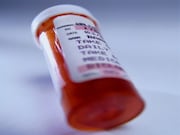Outpatient use at 90 days was seen for 5.9 and 3.0 percent of patients with and without inpatient use
TUESDAY, June 18, 2019 (HealthDay News) — Specific patterns of opioid administration to opioid-naive inpatients are associated with risk for long-term use after discharge, according to a study published online June 18 in the Annals of Internal Medicine.
Julie M. Donohue, Ph.D., from the University of Pittsburgh Graduate School of Public Health, and colleagues conducted a retrospective cohort study involving 148,068 opioid-naive patients with at least one outpatient encounter within 12 months before and after admission.
The researchers found that opioids were administered in 48 percent of admissions. Patients received opioids for a mean of 67.9 percent of their stay. After adjustment for potential confounders, outpatient use at 90 days was seen for 5.9 and 3.0 percent of inpatients receiving opioids and those without inpatient use, respectively. Higher 90-day opioid use was seen for inpatients receiving opioids less than 12 hours before discharge versus those with ≥24 opioid-free hours before discharge (7.5 versus 3.9 percent). Modest differences were seen based on the proportion of the stay with opioid use (opioid use at 90 days, 6.4 versus 5.4 percent for those with opioid use of ≥75 percent versus ≤25 percent of their hospital stay). Similar associations were seen for opioid use at 365 days after discharge.
“Our findings also highlight specific patterns of inpatient opioid prescribing that are associated with continued outpatient use and are likely amenable to health system interventions,” the authors write.
Copyright © 2019 HealthDay. All rights reserved.








